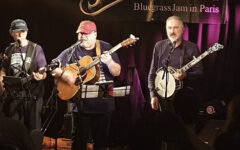
Country music singer and songwriter Mel Tillis passed away on November 19, 2017, at the age of 85. Following major surgery in 2016 the Country Music Hall of Famer never quite regained his full strength.
More associated as a country music crooner than having any connection with bluegrass music, Lonnie Melvin Tillis was the man behind writing such songs as Honey (Open That Door); I’m Tired; The Violet and A Rose (recorded for Columbia and a #24 hit for Tillis in 1958); Walk on Boy; Sawmill, (recorded for MGM and a #2 song on Billboard in 1972); Tennessee Banjo Man; and the classic Matterhorn, the song about the ill-fated group of four men who fell to their deaths on the descent after the first successful climbing in 1865 of one of the highest mountains in the Alps.
If they look familiar, well, Honey (Open That Door) and I’m Tired were recorded by Ricky Skaggs, admittedly in a country music vein; The Violet and A Rose, recorded by Jim & Jesse; and Larry Stephenson; Walk On, Boy was recorded by Doc Watson, the Rice Brothers, Bluegrass Gentlemen, Billy Strings and others; Sawmill was recorded by among others, the Bluegrass Gentlemen, and Del McCoury & The Dixie Pals; Tennessee Banjo Man was recorded by Doyle Lawson & Quicksilver; I Could Have Gone Right, penned by Tillis in the 1960s, is a track on Joe Mullins & Radio Ramblers’ 2017 CD The Story We Tell; and Matterhorn, most famously, was recorded by The Country Gentlemen and released in May 1967 as a single on Rebel Records.
Also, Tillis had an influence as an artist who, in addition to performing his own songs, recorded songs written by others. For instance, he had a #1 hit with Good Woman Blues, subsequently recorded by Delia Bell & Bill Grant; and IIIrd Tyme Out, and a #10 hit with New Patches, also a Top 10 hit for Tommy Collins and subsequently recorded by the Lynn Morris Band.
In a related vein, he also signed song-writer Damon Black to a publishing deal with his company, Sawgrass Music Publishers, Inc. While working for Tillis, Black wrote Arkansas (recorded by the Osborne Brothers), Sweet Mary and the Miles in Between (Bill Monroe, and Californian group High Country), Tall Pines (Bill & James Monroe; and Don Brown & the Ozark Mountain Trio) and Veil of White Lace (Walt Hensley & the Dukes of Bluegrass; Cliff Waldron & the New Shades of Grass; and The Traditional Grass).
We spoke to Pam Tillis, Mel’s daughter, who, not knowing that her father had recorded with Bill Monroe, invited the Father of Bluegrass Music to play on her recording of Till All the Lonely’s Gone (It’s All Relative: Tillis Sings Tillis, Lucky Dog EK-86546). She reflected on the musical melting-pot that existed in Nashville in the 1960s, reminding us of another Damon Black song, I Haven’t Seen Mary In Years (James Monroe, and Bill & James Monroe), “I haven’t thought about that… in years,” she confesses, “I remember that as a little girl”.
Do you think it be fair to say that he appreciated bluegrass music? … “absolutely, …. and same for myself, I have always had some kind of affinity for it; I love music that sounds like it’s pure …. and there is a purity and authenticity that I have always loved about bluegrass. I imagine I probably get that sense of musical open-mindedness from my dad.”
As a song-writer, and he started at a very young age, Tillis absorbed the music that was around him. Typically, that came in part from a common-place source …
“After everybody went to bed, daddy would sit on the front porch and listen to the Grand Ole Opry. Some of the biggest stars of the Grand Ole Opry were bluegrass artists … it [bluegrass] was in the mix that made daddy’s song-writing what it was. I have no doubts that it [bluegrass music] was in the mix.”
As mentioned, Pam Tillis recorded an album of her father’s songs, “there were all kinds of music, digging into daddy’s catalog; I found an amazing mix of styles. As a staff writer for Cedarwood Publishing … he wrote all kinds of music …”.
To underline that assertion, Alan Cackett, writing for Country Music People magazine in 1982, said of Mel Tillis. He possessed “the talent to write convincingly and commercially in diverse musical genres,” at one time writing the “very best honky-tonk songs every written;” then he altered his writing style to suit soft crooners.
Mel Tillis recorded what Cackett described as a “bluegrass-flavored” version of Before I Met You …. (not actually a Tillis song). Judge for yourself.
Mentions of Sawgrass brings to light Louisa Branscomb and her experiences with Mel Tillis. She remembers that he was the first to tell her that she was a professional songwriter ….
“Mel Tillis became aware of me in 1972 when his bass player, Larry Lee — a friend of mine who I’d met in college in Lynchburg, Virginia, where he’s from — happened to have a copy of a cassette version of me singing Steel Rails with guitar. They were headed to Texas, and Mel turned the bus around and went back to Nashville because he was so excited about the song. They went in the studio that day. He wanted to create a train rhythm for the song with drums and bass.
It didn’t turn out exactly how he wanted (I have it and it’s a little unusual!). He sent the song to Johnny Cash who said he might record it too if Mel didn’t cut it first.
Then he invited me to Nashville to play songs for him. So, I came to Sawgrass one morning and he put his feet up and drank coffee and made notes on every song, and I played him about 45 songs. He picked five to publish including Steel Rails. He didn’t release his version, but I have it somewhere. He gave it to Johnny Cash and said he loved it and was planning to record it, but then got sick. He said I should move to Nashville and he was sure I would have a career as a songwriter, and he would help me. He said, ‘Nashville needs a new woman songwriter.’ But I had a band in North Carolina and had fallen in love with the banjo. And I was very young [about 21 years old] and didn’t know the opportunity in front of me!
So, Mel was the first to actually cut Steel Rails. Then the McPeak Brothers, then my band Boot Hill, in 2007, which is the version Alison heard and recorded from.”
Tillis “discovered” the McPeak Brothers and got them a deal with RCA Victor that resulted in one album, Bluegrass at Its Peak. This came about after the addition of fiddler Ernest Atkins to the McPeak Brothers’ band about 1969. Atkins’ friendship with Mel Tillis helped the band to get onto Tillis’ syndicated TV show, which then led to that contract with RCA.
Mel Tillis recorded one song with Bill Monroe; My Louisiana Love, for the Bill Monroe & Friends album, released in the early 1980s.
The recording is terminated early in that video, but it is the last track here. Note the humorous exchange at the beginning of the song
The most well-known link between Mel Tillis and bluegrass music is the song Matterhorn, due to the recording by the early Country Gentlemen – Charlie Waller (lead vocals and guitar), John Duffey (tenor vocals and mandolin), Eddie Adcock (baritone vocals and banjo), Ed Ferris (bass) – on June 15, 1966.
This recording has been released by Rebel Records on three occasions; 25 Years (REB-1102, in 1980) and Country Gentlemen 1962-1971 (REB-4002, 1998) and Can’t You Hear Me Callin’ : Early Classics, 1963-1969 (REB-7508, 2003).
Adcock remembers ….
“That was one of my most famous banjo breaks of all time. I think of the banjo players that have come up to me, they´ll mention the kick-off to Matterhorn right off.”
In sharing this extract from her forthcoming book about Eddie Adcock, Martha Hearon Adcock provides an in-depth review of the Country Gents’ recording ….
Eddie Adcock may be known primarily for a widely eclectic, improvisational playing style that includes his single-string work, string-bending, syncopated bounce, pedal-steel-style finger-joint hammer-ons, whistlers and zonkers, and sophisticated, sensitive back-up… but to many of us what will always be one of his most memorable Country Gentlemen tunes — Matterhorn — kicks off with a goose-pimple-making roll.
Indeed, the electrifying cold-steel high-D banjo intro on Matterhorn is one of the most distinctive and beloved musical statements in all of the Gents repertoire. When it was introduced, the song quickly became one of the band’s signature tunes, and icon status has since been accorded the piece and the banjo sound.
Eddie says, “It became popular with audiences as soon as we started doing it. Playing a banjo in D chord capo-ed at the seventh fret is ear-grabbing. Kicking it off and going right into the minor key sounded so cool to me. When I came up with it I loved it, and the guys immediately did too. It was a really good effect, just sort of stunning. When we kicked it off onstage, the audience would go ‘WoooOOOoo!!’, like the hair had been raised on the back of their necks. People would tell me that the Epiphone banjo sounded like a silver hammer hitting a golden anvil.”
“I always liked playing in high-D position, what I call a ‘bluegrass open D’. I like playing in D position down low too, in D tuning, like for Black Mountain Rag. A banjo just absolutely sounds really, really good played in any kind of D.”
Matterhorn is played out of a G position in G tuning with the banjo capo-ed at the seventh fret; the fifth string is capo-ed at the twelfth fret. The classic sound of the song simply cannot be duplicated otherwise.
Matterhorn was originally recorded by the Gents for their The Traveler LP on Rebel Records, and it was subsequently re-released on three different sets of compilations from that company. Then Eddie and I recorded it for Patuxent on the Many A Mile CD. I asked him about the song’s provenance.
Q: Eddie, where did you pick up on Matterhorn. How did it get into the Gents repertoire?
A: “It’s odd, but I can’t remember for certain how we came across Matterhorn! Mel Tillis wrote it, and it seems like I may have heard it on the radio at WKCW in Warrenton, Virginia, or somewhere like that, since I was still listening to country radio at the time. Some of it was still the good classic music in the ’60s; not all of it had gone ‘countrypolitan’ yet. And what’s odd is that I’ve always thought I’d originally heard a record of Matterhorn by Mel, but we can’t find any evidence that he recorded it! Maybe I heard him sing it live on an early package show. Those were popular in my neck of the woods, and I’d worked a bunch of them in several states before I joined the Gentlemen.
“So I’m not really sure how I discovered Matterhorn. Martha hasn’t found it on any Mel Tillis discographies or in other information except BMI’s listing, and she says it doesn’t show up in connection to the song’s co-writer Fred Burch anywhere either except there and at their publisher, Universal Cedarwood. The Gents’ Rebel box set notes quote Charlie Waller saying he learned it from a guy he was giving guitar lessons to; but I have no idea who that might have been, or what the circumstances were… or even that Charlie ever gave any lessons! All I really know is that when I heard the song, I knew I wanted to do it and wanted to speed it up and put some really powerful banjo on it, and it seems like the kick-off came to me the first time I heard it.”
Q: Nobody else in bluegrass had done it, had they?
A: “Definitely not. Paperwork says Mel wrote it in 1963; and the Gentlemen recorded it in 1966 on the Traveler album for Rebel Records. It was an instant hit with audiences.
“On the package shows back when bluegrass was mixed in with the country music, the Country Gentlemen played a number of them. Mel Tillis was on a bunch of those with us, and he told me he really liked my banjo kick-off on Matterhorn, that it was very different from the way he did it. He liked the punch that banjo kick-off gave the song, and he said it was so special that it ‘made his mind come alive,’ as he called it; and he said that from then on when he was thinking of the song, he always heard my kick-off in his head. He also told me he pitied the lead singer who had to come in after that banjo intro!
“When Martha and Tom Gray and I toured Europe in 2012, we played Matterhorn and the other songs from our new Many A Mile CD. People there went extra-crazy for that song, especially at a show in Switzerland — they just came apart! Of course, by then, fans all around the world had known the song by the Country Gentlemen for many years, but when I kicked it off that evening the Swiss crowd really went extra-nuts. I turned around and looked out the window, and there stood the Matterhorn itself.”
Another Country Gentlemen recording of Matterhorn is on the Live in Japan (Seven Seas SR 756-7, recorded in January 1971) album, featuring Charlie Waller (guitar), Bill Emerson (banjo), Doyle Lawson (mandolin) and Bill Yates (bass). Re-released on CD Live in Japan (Rebel 1104, 1988).
Matterhorn proved to be such a popular song in bluegrass music circles that it has been recorded by a considerable number of bands.
These are some bluegrass groups that have recorded the song:
- The Sunshine Bluegrass Boys (released in 1977); The New Grass Edition (1978); Free N’ Easy (1979); and The Williams Family (as “Matahorn” – thought to have been during the 1970s)
- The New County Line (1980); Yankee Bluegrass (1983); Fayette Station (1983); Keystone Grass (1984); Bluegrass Generation (1987); Close to Home (1988)
- Bluegrass Tradition Band (2002); The Wes Miller Band (2003); Carolina Sonshine (2006); Wood & Steel (2007); Bill Yates & Friends (2009)
- Bluegrass Brothers; The Dixie Flyers; and Jasper Junction (all thought to have been during the first decade of this century)
- Blue Canyon Boys (2010); Bluestone (2010); Gary Ruley & Mule Train (2010); Eddie & Martha Adcock (2011); Hard Knox (2012); Dave Kline & the Mountain Folk Band (2015).
- Lester Flatt & the Nashville Grass, with the Country Gentlemen, has a version of Matterhorn on a DVD; First Generation Bluegrass (recorded in 1971 in Renfro Valley, Kentucky, at Mac Wiseman’s festival).
In 1976 Tillis won the Country Music Association Awards’ most coveted award, Entertainer of the Year, and he was also inducted into the Nashville Songwriters Hall of Fame that year.
In consideration of his 80-plus writer awards, Tillis was hailed twice as BMI Songwriter of the Decade. Actually, he was inducted into the Nashville Songwriters Association International’s Songwriters’ Hall of Fame in 1976, and belatedly accorded WSM’s Grand Ole Opry cast membership status in 2007, in which daughter Pam was already a member.
In 2012 President Barack Obama awarded Tillis the National Medal of Arts for his contributions to country music.
Inspiration for this story and a lot of significant basic information came from Jon Weisberger. Interview with Pam Tillis conducted by John Lawless. Transcription by Karen L Thompson. Mistakes are by me.








